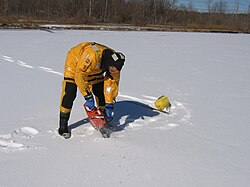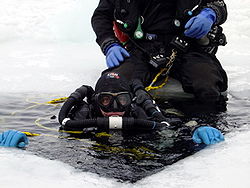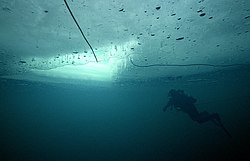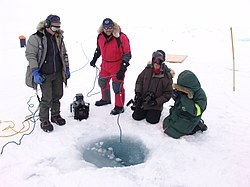Ice diving in Antarctica. Check out film blog for more: http://kirkoftheantarctic.wordpress.com/
Here we see the dive crew cutting holes in the 45cm sea ice and then going in for a dive to collect scientific samples to help with learning about global climate change. To see more Antarctic film blogs check out 'extremefilm' channel.
Seems like a lot of work to get wet doesn't It?
Ice diving is a type of penetration diving where the dive takes place under ice.[1][2] Because diving under ice places the diver in an overhead environment typically with only a single entry/exit point, it is considered an advanced type of diving requiring special training (although whether it constitutes technical diving is part of a wider debate within the diving community). Ice divers are generally tethered for safety. This means that the diver wears a special harness under the scuba unit. A line is secured to this harness, and the other end of the line is secured above the surface by one of a number of methods.
The diver also can use a weight harness, integrated weight buoyancy control device, or a weight belt with two buckles on it so the weights can not be accidentally released which would cause a run-away ascent into the ice sheet.
Ice diving is a team diving activity because the divers line requires a line tender. This person is responsible for paying out and taking in line so that the diver does not get tangled. Communication to the diver, or to the surface, is accomplished by pulling on the line. Each series of tugs means a different thing.
There is a diver suited up and ready to enter the water at a moment's notice.
This diver is a safety diver, and has his own tender. His purpose is to assist the primary diver in the event of a problem.
Divers who do not use a tether require extra training and full redundant scuba systems.[citation needed]
Polar diving experience has shown that buoyancy control is the critical skill affecting safety.[2]
Ice Diving - View from the top
Under the ice - view from below
Equipment
Since diving under the ice takes place in cold climates, there is typically a large amount of equipment required.Besides each person's clothing and exposure-protection requirements, including spare mitts and socks, there is basic scuba gear, back-up scuba gear, tools to cut a hole in the ice, snow removal tools, safety gear, some type of shelter, lines, and refreshments[citation needed] required.
Exposure suits
Because of the water temperature (between 4°C and 0°C in fresh water, approximately -1.9°C for normal salinity sea water), exposure suits are mandatory.[3]- Pre- and post-dive thermal protection is critical for safety and diver function.[2]
- Hand thermal protection is important to retain functionality and prevent cold injury.[2]
- The diver should be kept warm throughout the dive, but active rewarming by external heating and heavy exercise should be avoided directly after the dive, as the effect of cold on risk of decompression sickness is not fully understood.[2]
Some consider a dry suit mandatory; however, a thick wetsuit may be sufficient for hardier divers.
A wetsuit can be pre-heated by pouring warm water into the suit.
A hood and gloves (recommended three-finger mitts or dry gloves with rings) are necessary, and dry suit divers have the option of using hoods and gloves that keep their head and hands dry.
Some prefer to use a full face diving mask to essentially eliminate any contact with the cold water.
The biggest drawback to using a wet suit is the chilling effect on the diver caused by the water evaporating from the suit after a dive. This can be reduced by using a heated shelter.

Cutting a hole in the ice to check the water conditions
Checking water conditions through a small hole in the ice
Scuba equipment
A diving regulator suitable for cold-water is used. All regulators have a risk of freezing and free flowing, but some models fare better than others.[4]Environmentally sealed regulators avoid contact between the surrounding water and the moving parts of the first stage by isolating them in an antifreeze fluid (e.g. Poseidon)[1] or by siting the moving parts behind a diaphragm and transmitting the pressure through a pushrod (e.g. Apeks).
Although there is no universally accepted standard, at least one agency[5] recommends the use of two non-freezing regulators arranged as follows: primary first stage with primary second stage, BCD inflation hose, and submersible pressure gauge (SPG); secondary first stage with secondary second stage (octopus), dry suit inflation hose, and SPG, although only one SPG is needed for a single cylinder or manifolded twins.
The two first stages are mounted on independently closable valves, as a first stage freeze free-flow can only be stopped by shutting off the air supply from the cylinder until the valve has thawed out.
The second regulator is there to supply the remaining gas when the first regulator is shut off.
A second-stage isolation valve used in conjunction with a first-stage overpressure relief valve may be effective as a quick method to manage demand valve free-flow.[2]
- Regulators should be checked to ensure that they perform effectively at low temperatures before use far from a free surface.[2]
- A minimum of two independent regulators is recommended for diving under ice, as scuba apparatus has a tendency to free-flow under polar conditions Divers must be competent in change-over procedures, including shutdown of the free-flowing equipment.[2]
- Keeping regulators warm and dry before diving, and limiting breathing from the regulator before immersion will reduce the risk of regulator freezing. Purging or any other cause of high flow rate markedly increases the probability of freezing and should be kept to an absolute minimum.[2]
Each of the 2nd stages is supplied its own first stage, which can be shut down at the cylinder valve in an emergency, such as a free flow.
The diver’s bcd is on a different 1st stage to the drysuit so if there is an issue with one the diver can still control his buoyancy.
Most divers also use a primary regulator on a 7-foot hose and a secondary on a necklace, this is especially important when not using tethers so the divers can swim in a horizontal line.
The reason for the primary being on a long hose is to ensure the diver who has an issue will get a known good regulator.
Also there is less chance of the donor rolling off the regulator that was given to the diver in the emergency situation.
Buoyancy and weighting
- A drysuit should be used with a buoyancy compensator for ice diving unless the diver exposed to greater risk with a buoyancy compensator than without one.[2]
- A tethered diver, who is deployed to work independently, should preferably be equipped with full face mask, voice communications to the surface and redundant air supply. This is often obligatory for professional divers.[2]
- Most divers prefer to be more negative for ice diving than in open water like in most overhead environments, and learning to disconnect the low pressure inflator on a BCD or drysuit is a critical skill.
Surface team.
- Adequate thermal protection must be provided to tenders and standby divers.[2]
-
- Warm waterproof shoes.
- Warm anorak for cold weather.
- Warm cap covering the ears.
- Sunglasses with a UV filter to protect the eyes in sunny days.
- Lip-care stick and cream to protect hands and face against cold and wind.
- A device like crampons to aid in traction on ice. especially when cutting the hole or carrying gear
Procedures and precautions
- A snow shovel is used to clear the snow and ice from the area.
- An ice saw or a chain saw is used to cut a hole in the ice.
- A weatherproof area is used for the divers to suit up.
- The diver and tender on the surface are connected by a rope and harness. The harness is typically put on over the dry suit but under the BC or other buoyancy device so that the diver remains tethered even if he or she must remove the air cylinder or buoyancy control device. The harness fits over the shoulders and around the back such that the tender on the surface can, in an emergency, haul an unconscious diver back to the hole. The harness should not be able to slide up the diver's torso when pulled.
- Rope signals or voice communications systems must be used.
- A roped standby diver is ready on the surface.
- One or two divers may dive at the same time from the same hole, each with his or her own rope. Using two ropes runs little risk of getting tangled together, but using three significantly increases this risk.[citation needed]
- If the regulator free-flows and freezes, the diver should close it down and switch to the backup, and terminate the dive.
- When diving in pack ice, the surface team must constantly monitor ice movement to ensure that the exit is not compromised.[2]
- The diver must ensure that there is always a positive indication of the route to the exit area. A tether to a surface tender is usually preferable as it can be used to communicate,[2] but if this is not practicable a reel and distance line is an alternative.
- The risk of attack by predators should be considered. Polar bear and leopard seal may be hazards in some areas.
- Gas management for an overhead environment is appropriate.
- Deployment of a single tethered scuba diver is a reasonable and safe alternative to free-swimming buddy team diving. The tethered scuba diver is equipped with a full-face mask with voice communications, high capacity scuba air supply, and an independent emergency air supply. A lifeline with communications cable is secured to a body harness on the diver and is handled by a surface tender who is in constant voice communication with the diver. A similarly equipped standby diver is available on the surface.[6]
Training
Training includes learning about how ice forms, how to recognize unsafe ice conditions, dive site preparation, equipment requirements, and safety drills.- Ice divers should be skilled in the use of drysuits, choice of thermal insulation, buoyancy control and weighting, and should be competent and experienced with the specific equipment they will use.[2]
- If lifelines are used, both divers and tenders must be competent to use them.[2]
- How to impact the underside of the surface ice if the diver's weight belt falls off for any reason and the diver ascends uncontrollably and rapidly.
- How to deal with a frozen air-supply system using a redundant back-up system.
- What to do in the event the diver loses contact with the line or the line tender does not get feedback from the diver in response to signals given to the diver.
Hazards
Hazards of ice diving include the general hazards of penetration diving, and some hazards that are more specific to the low temperature and overhead environment.- Frostbite
- Hypothermia
- Non-freezing cold injury
- Regulator freezing
- Entrapment by moving ice
- Slipping on ice since scuba gear is heavy outside of the water. Also the water on the divers exposure suit can quickly freeze reducing mobility and traction
Regulator freezing
When air expands during pressure reduction in a regulator, the temperature drops and heat is absorbed from the surroundings.[7] There are two possible ways for a regulator to freeze and free-flow.First stage freeze
Air from the diving cylinder is subjected to a dramatic reduction in pressure - as much as 220 bar from a full 230 bar cylinder at the surface - when passing through the regulator first stage.This lowers the temperature of the air, and heat is absorbed from the components of the regulator.
As these components are largely metal and therefore good conductors of heat energy, the regulator body will cool quickly to a temperature lower than the surrounding medium.
When immersed in water during a dive, the water surrounding the regulator is cooled and, if this water is already very cold, it can freeze.
If the water in direct contact with the pressure transfer mechanism (diaphragm or piston and the spring balancing the internal pressure) of the regulator freezes, the mechanism will be locked in the position at which the freezing takes place, as the ice will prevent the movement required to close.
Since the cooling takes place during flow through the regulator, it is common for the freezing to occur when the first stage valve is open, and this will freeze the valve open, allowing a continuous flow through the first stage.
This will cause the interstage pressure to rise until the second stage opens to relieve the excess pressure, the pressure relief valve on the first stage opens, or a low pressure hose or fitting bursts.
All of these effects will allow the flow through the first stage to continue, so the cooling will continue, and this will keep the ice causing the problem frozen.
To break the cycle it is necessary to stop the gas flow or expose the ice to a heat source capable of melting it.
While underwater, it is unlikely to find a heat source to thaw the ice and stopping the flow is only option.
Clearly the flow will stop when the pressure in the cylinder drops to ambient, but this is undesirable as it means total loss of the breathing gas.
The other option is to close the cylinder valve, shutting off the pressure at the source.
Once this is done, the ice will normally melt as heat from the surrounding water is absorbed by the slightly colder ice, and once the ice has melted, the regulator will function again.
This freezing can be avoided by preventing water from coming into direct contact with cooled moving parts of the regulator mechanism,[1][8] or by increasing the heat flow from the surrounding environment so that freezing does not occur.[9]
Both strategies are used in regulator design.
Second stage freeze
A similar effect occurs with the second stage. Air which has already expanded and cooled through the first stage expands again and cools further at the demand valve of the second stage.This cools the components of the second stage and water in contact with them may freeze. Metal components around the moving parts of the valve mechanism allow heat transfer from the surrounding slightly warmer water, and from exhaled air from the diver, which is considerably warmer than the surroundings.
A second stage freeze is also likely to happen with the valve open, causing a free flow, which may precipitate a first stage freeze if not immediately stopped.
If the flow through the frozen second stage can be stopped before the first stage freezes, the process can be halted.
This may be possible if the second stage is fitted with a shutoff valve, but if this is done, the first stage must be fitted with an overpressure valve, as closing the supply to the second stage disables its secondary function as an overpressure valve.
Source: Wikipedia.org
Somebody Come and Play In the Traffic With Me! Earn as You Learn, Grow as You Go!
The Man Inside the Man
from
Sinbad the Sailor Man
A
JMK's Production
Share this page, If you liked It Pass it on, If you loved It Follow Me!
TTFN
CYA Later Taters!
Thanks for watching.
Donnie/ Sinbad the Sailor Man
Somebody Come and Play in "Traffic" with me. If you would like to "Join" A Growing Biz Op! Here is Your Chance to get in an Earn While You Learn to Do "The Thing" with us all here at Traffic Authority.
Simply click this link and Grow as you Go Come and Play In Traffic With Me and My Team at Traffic Authority!
Simply click this link and Grow as you Go Come and Play In Traffic With Me and My Team at Traffic Authority!
P.S. Everybody Needs Traffic! Get Top Tier North American Traffic Here!








No comments:
Post a Comment